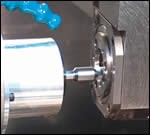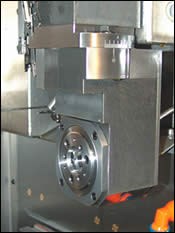Thread Whirling On The Subspindle
The screw machine industry, not surprisingly, started out making screws. Then, screw machines were used to make almost everything but screws—electrical components, aerospace fasteners, plumbing connections and thousands of other kinds of parts.
The screw machine industry, not surprisingly, started out making screws. Then, screw machines were used to make almost everything but screws—electrical components, aerospace fasteners, plumbing connections and thousands of other kinds of parts. Many shops searched high and low for jobs that could give entrance to other industry segments.
Therefore, it is ironic that (thanks to technical advances) machine tools' ability to cut exotic materials coupled with the demand for orthopedic repair parts are once again manufacturing screws. However, this time they are for the human body. Our physically active and aging population is generating a demand for orthopedic repair parts that's unprecedented and guaranteed to grow (see "Medical Industry Statistics" below).
Barely a day goes by that Production Machining doesn't receive a submission for something to do with machining parts for the medical industry, and most often, bone screws. The job facing medical parts manufacturers is how to select the most efficient metalworking techniques from numerous methods.
Thread whirling is one such technique that has become popular for efficiently cutting quality threads on bone screws. Common materials used are 316, 316l, 303 stainless and titanium—none of which is easy to cut because of the bone screws' sharp angles, thread lengths and large differences between the root and head diameters.
An external thread-whirling tool is basically a ring with inserts mounted on the ID. A machine-mounted attachment carries the tool and rotates it at a high speed relative to the slower rotating workpiece. The ring is positioned slightly off center from the part so that a single cutter engages the work per rotation. This creates a nibbling action that produces burr-free threads. The thread pitch is set by the angle of the cutter ring to the workpiece.
CNC Swiss-type machines are well applied to this technique because the moving headstock feed can be programmed to synchronize with the thread-whirling attachment. On most bone screws, the process involves first whirling the thread on the main spindle, then handing the part off to the subspindle to perform backworking operations to cut the screw head and driver connection.
For use on its Deco line of Swiss-type machines, Tornos Technologies (Brookfield, Connecticut) has developed a thread-whirling attachment that provides added flexibility of machining threads on the subspindle. This attachment was specifically developed for cutting larger-size threads typically found on hip or "lag" orthopedic bone crews. As shown in the photograph on the left, these screws have a relatively straight shank that is easily gripped in the subspindle collet.
However, there are generally several operations performed on the shank of these cannulated (tubular) parts including drilling, turning, gundrilling, broaching, deburring, tapping and cut-off on the main spindle. On the opposite end of the part, additional operations can include drilling, thread whirling, thread deburring and milling in the counter spindle. Complex as these screws are, all of the necessary operations can be completed in a single machine using both spindles while eliminating secondary operations.
Applying CNC Swiss-type machines to medical parts manufacturing brings the flexibility of these multi-axis machines to bear on a market segment that demands 100 percent quality, large varieties of shapes and sizes and lot sizes that are relatively small. The idea behind developing the ability to thread on the subspindle, if needed, is to add production flexibility to help shops balance the front and backworking operations for these complex parts so throughput can be optimized.
Related Content
Laser Technology "Turns" into a Turning Tool
This new technology uses a laser to act as a cutting tool to "turn" parts from solid barstock. This high-speed precision turning machine is especially useful for micromachining, enabling high accuracy for small, complex parts that are often delicate and difficult to machine when implementing conventional turning processes.
Read MoreThe Control’s Role in Machining Complex Parts
This company that produces medical implants finds value in the CNC for its turn-mill equipment that helps speed setups and simplify programming when producing intricate parts complete.
Read MoreFive-Axis Machining for Small Prismatic Parts
New to the U.S. market, this compact machine could enable precision turning shops to win complex, more prismatic work in medical and other industries.
Read MoreNew Cutting Tool Technology Discovered at Paul Horn Open House
During a tour of the company’s campus in Tubingen, Germany, I and more than 3,000+ others were introduced to a number of new advances the company has made in cutting tool technology particularly as it relates to the medical industry.
Read MoreRead Next
A Tooling Workshop Worth a Visit
Marubeni Citizen-Cincom’s tooling and accessory workshop offers a chance to learn more about ancillary devices that can boost machining efficiency and capability.
Read MoreDo You Have Single Points of Failure?
Plans need to be in place before a catastrophic event occurs.
Read More5 Aspects of PMTS I Appreciate
The three-day edition of the 2025 Precision Machining Technology Show kicks off at the start of April. I’ll be there, and here are some reasons why.
Read More

















.png;maxWidth=300;quality=90)








